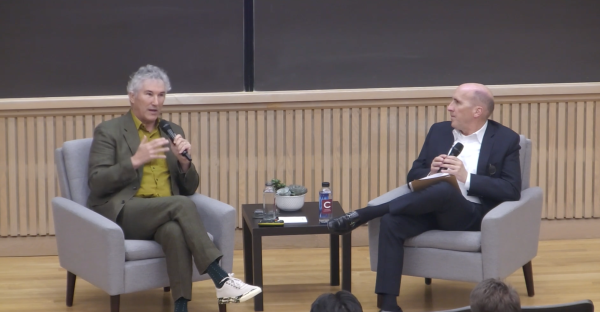Water, Water Everywhere
On Sunday, January 22, a 10-inch village water main break in the Cutten parking lot wreaked havoc throughout much of lower campus, causing flooding and water shortages.
Water pouring from the break flooded the Cutten parking lot, leaving several feet of standing water in places that had to be pumped out by fire trucks.
The break also left much of the lower campus, including the Townhouses, Cutten and the Huntington Gymnasium facilities and village properties near the break, without water almost all day Sunday.
“It was not a good welcome back present,” sophomore David McKenzie said. “It was inconvenient to not be able to take a shower. I walked all the way to Drake, and when I got there, they only had cold water.”
Like McKenzie, other students were not pleased with the break.
“I was inconvenienced at first since I was doing a load of laundry, but I’m not complaining, because I saw the destroyed car,” sophomore Andy Holway said.
The “destroyed car” Holway saw belongs to sophomore Julia Heymans and was one of three damaged by the flooding. The car’s electrical system was ruined by the water and according to Heymans, the University passed responsibility for the water main break – and thus the damage to her car – to the Village of Hamilton, as it was in fact a village pipe that broke.
Heymans expects that the Village will try to pass responsibility back to the school, but added that she intends to try again to get the school to pay for it, if Hamilton refuses. According to the University, the problem is still being looked into.Hamilton Community Memorial Hospital also suffered a loss of water due to the break. The hospital was left without access to potable water and was forced to purchase water coolers and ten 50 gallon jugs of water from Valley Water in order to provide drinking water. The kitchen was also left without water and had to switch to a menu that did not require cooking.
In addition to the problems caused by a lack of potable water, the hospital lacked running water with which to flush toilets, leaving the toilets to be flushed by hand by the maintenance staff. The necessary water was supplied by filling 30 gallon garbage buckets from a sump pump in the basement and transported throughout the building on carts.
Nurses also complained about having to scrub their hands with alcohol instead of soap and water in order to clean them.
Finally, the absence of water prevented the steam boilers from running, which left much of the hospital without heat.
“If it had been colder we would have had a problem and would have had to shut down parts of the hospital,” Director of Building Services for the hospital Mike Moshier said. Thanks to the relative warmth, though, the only thing that had to be shut down was the autoclave, which sterilizes instruments for surgery.
“Fortunately, it was Sunday, and we didn’t need the operating room,” Moshier said.
Still, Moshier was satisfied with the effectiveness of the hospital’s response to the crisis.
“We have plans in place we go to, and that was the plan,” he said. “It was very successful. We still took care of all the patients.”
The water main break also provided a learning experience for hospital staff.
“We are looking for an alternate source of water for steam heat – possibly a well – as a result of this,” Moshier said.
The break has since been repaired and the water supply restored to affected areas.




